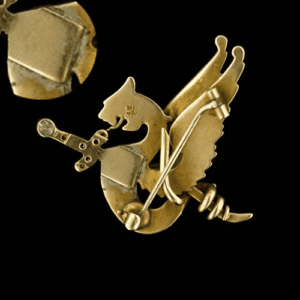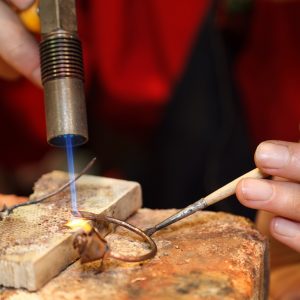
Solder is an alloy of nonferrous metal that, when melted, becomes fluid and bonds with the metals to be joined. The alloy used is constituted to have a melting and flow point lower than the metals being soldered. The fluid solder flows through the space between the metals being joined and becomes a permanent filler. A bond results and the soldered items are joined together. It is imperative that the items to be bonded are clean and fit well together. Often a flux is added to protect the metal surface from oxidation during the soldering process and to alter the surface tension of the molten solder.
The particular alloy used depends on the metals to be bonded. Platinum solders are 60-70% gold with platinum, palladium (or other platinum family metal), or silver to give it a white color. Platinum solder can have a higher melting point because platinum itself has a very high melting point. Gold solders are alloys of gold, copper, and silver with the low-temperature melting solders having an addition of cadmium, bismuth, zinc, or tin. The proportions of gold to other metals are manipulated so the solder matches the color of the gold on which it’s being applied. Silver solder usually contains silver and copper, sometimes zinc is added.
A range of melting points for each type of solder is generally available so that the item being assembled or repaired can be soldered multiple times without releasing earlier solder joints. Generally, they run the gamut from very hard (highest temperature melting point) through several lower melting ranges to easy (the lowest melting solder available.)

An item is considered to be soldered when it has been bonded through the use of solder. The process of soldering varies according to the metals being bonded, the temperature required to melt the solder, and the oxidation properties of the metals involved. A vast array of tools are used to work with solder, to clamp the items to be soldered, and to do the actual soldering. These tools are also dependent on the metals being soldered and the solder’s melting point. The actual fuel used to generate the soldering flame also varies, sometimes by the user’s choice and sometimes dictated by the item being soldered.
There are three basic steps to soldering:
- Preheating the entire item.
- Localized heat on the solder joint.
- Heat withdrawal.
Post-soldering most items are put into a pickling or acid bath to remove fire stain, surface oxide, flux, and other residues.
Note: In jewelry, we sometimes see the use of inappropriate, extremely low-temperature melting solders such as lead solder. This happens when a repair person wants a quick repair without the hassle of determining what has occurred earlier in the manufacture or repair of an item. These joins are sometimes visible and unsightly and can often be remedied by the use of modern technology such as a jewelry laser.